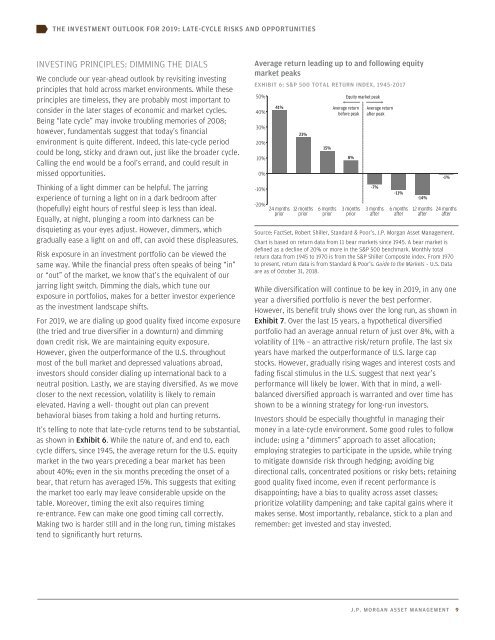You also want an ePaper? Increase the reach of your titles
YUMPU automatically turns print PDFs into web optimized ePapers that Google loves.
THE INVESTMENT OUTLOOK FOR 2019: LATE-CYCLE RISKS AND OPPORTUNITIES<br />
INVESTING PRINCIPLES: DIMMING THE DIALS<br />
We conclude our year-ahead outlook by revisiting investing<br />
principles that hold across market environments. While these<br />
principles are timeless, they are probably most important to<br />
consider in the later stages of economic and market cycles.<br />
Being “late cycle” may invoke troubling memories of 2008;<br />
however, fundamentals suggest that today’s financial<br />
environment is quite different. Indeed, this late-cycle period<br />
could be long, sticky and drawn out, just like the broader cycle.<br />
Calling the end would be a fool’s errand, and could result in<br />
missed opportunities.<br />
Thinking of a light dimmer can be helpful. The jarring<br />
experience of turning a light on in a dark bedroom after<br />
(hopefully) eight hours of restful sleep is less than ideal.<br />
Equally, at night, plunging a room into darkness can be<br />
disquieting as your eyes adjust. However, dimmers, which<br />
gradually ease a light on and off, can avoid these displeasures.<br />
Risk exposure in an investment portfolio can be viewed the<br />
same way. While the financial press often speaks of being “in”<br />
or “out” of the market, we know that’s the equivalent of our<br />
jarring light switch. Dimming the dials, which tune our<br />
exposure in portfolios, makes for a better investor experience<br />
as the investment landscape shifts.<br />
For 2019, we are dialing up good quality fixed income exposure<br />
(the tried and true diversifier in a downturn) and dimming<br />
down credit risk. We are maintaining equity exposure.<br />
However, given the outperformance of the U.S. throughout<br />
most of the bull market and depressed valuations abroad,<br />
investors should consider dialing up international back to a<br />
neutral position. Lastly, we are staying diversified. As we move<br />
closer to the next recession, volatility is likely to remain<br />
elevated. Having a well- thought out plan can prevent<br />
behavioral biases from taking a hold and hurting returns.<br />
It’s telling to note that late-cycle returns tend to be substantial,<br />
as shown in Exhibit 6. While the nature of, and end to, each<br />
cycle differs, since 1945, the average return for the U.S. equity<br />
market in the two years preceding a bear market has been<br />
about 40%; even in the six months preceding the onset of a<br />
bear, that return has averaged 15%. This suggests that exiting<br />
the market too early may leave considerable upside on the<br />
table. Moreover, timing the exit also requires timing<br />
re-entrance. Few can make one good timing call correctly.<br />
Making two is harder still and in the long run, timing mistakes<br />
tend to significantly hurt returns.<br />
Average return leading up to and following equity<br />
market peaks<br />
EXHIBIT 6: S&P 500 TOTAL RETURN INDEX, 1945-2017<br />
50%<br />
40%<br />
30%<br />
20%<br />
10%<br />
0%<br />
-10%<br />
-20%<br />
41%<br />
24 months<br />
prior<br />
23%<br />
12 months<br />
prior<br />
15%<br />
6 months<br />
prior<br />
Equity market peak<br />
Average return<br />
before peak<br />
8%<br />
3 months<br />
prior<br />
Average return<br />
after peak<br />
-7%<br />
3 months<br />
after<br />
-11%<br />
6 months<br />
after<br />
-14%<br />
12 months<br />
after<br />
-1%<br />
24 months<br />
after<br />
Source: FactSet, Robert Shiller, Standard & Poor’s, J.P. Morgan Asset Management.<br />
Chart is based on return data from 11 bear markets since 1945. A bear market is<br />
defined as a decline of 20% or more in the S&P 500 benchmark. Monthly total<br />
return data from 1945 to 1970 is from the S&P Shiller Composite index. From 1970<br />
to present, return data is from Standard & Poor’s. Guide to the Markets – U.S. Data<br />
are as of October 31, 2018.<br />
While diversification will continue to be key in 2019, in any one<br />
year a diversified portfolio is never the best performer.<br />
However, its benefit truly shows over the long run, as shown in<br />
Exhibit 7. Over the last 15 years, a hypothetical diversified<br />
portfolio had an average annual return of just over 8%, with a<br />
volatility of 11% – an attractive risk/return profile. The last six<br />
years have marked the outperformance of U.S. large cap<br />
stocks. However, gradually rising wages and interest costs and<br />
fading fiscal stimulus in the U.S. suggest that next year’s<br />
performance will likely be lower. With that in mind, a wellbalanced<br />
diversified approach is warranted and over time has<br />
shown to be a winning strategy for long-run investors.<br />
Investors should be especially thoughtful in managing their<br />
money in a late-cycle environment. Some good rules to follow<br />
include: using a “dimmers” approach to asset allocation;<br />
employing strategies to participate in the upside, while trying<br />
to mitigate downside risk through hedging; avoiding big<br />
directional calls, concentrated positions or risky bets; retaining<br />
good quality fixed income, even if recent performance is<br />
disappointing; have a bias to quality across asset classes;<br />
prioritize volatility dampening; and take capital gains where it<br />
makes sense. Most importantly, rebalance, stick to a plan and<br />
remember: get invested and stay invested.<br />
J.P. MORGAN ASSET MANAGEMENT 9
















